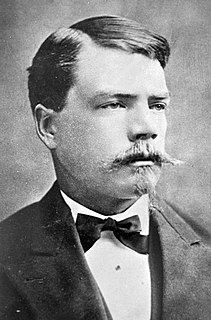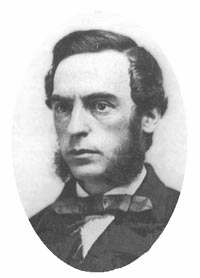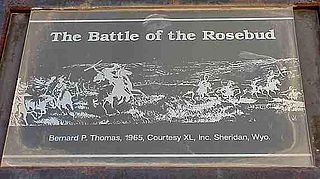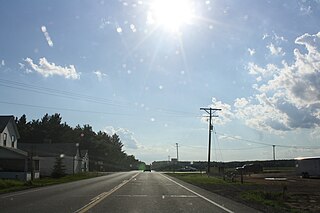
The Battle of the Little Bighorn, known to the Lakota and other Plains Indians as the Battle of the Greasy Grass and also commonly referred to as Custer's Last Stand, was an armed engagement between combined forces of the Lakota, Northern Cheyenne, and Arapaho tribes and the 7th Cavalry Regiment of the United States Army. The battle, which resulted in the defeat of U.S. forces, was the most significant action of the Great Sioux War of 1876. It took place on June 25–26, 1876, along the Little Bighorn River in the Crow Indian Reservation in southeastern Montana Territory.

George Armstrong Custer was a United States Army officer and cavalry commander in the American Civil War and the American Indian Wars.

The Tongue River is a tributary of the Yellowstone River, approximately 265 mi (426 km) long, in the U.S. states of Wyoming and Montana. The Tongue rises in Wyoming in the Big Horn Mountains, flows through northern Wyoming and southeastern Montana and empties into the Yellowstone River at Miles City, Montana. Most of the course of the river is through the beautiful and varied landscapes of eastern Montana, including the Tongue River Canyon, the Tongue River breaks, the pine hills of southern Montana, and the buttes and grasslands that were formerly the home of vast migratory herds of American bison. The Tongue River watershed encompasses parts of the Cheyenne and Crow Reservations. The Headwaters lie on the Big Horn National Forest, and the watershed encompasses the Ashland Ranger District of the Custer National Forest.
The Mandan, Hidatsa, and Arikara Nation, also known as the Three Affiliated Tribes, is a Native American Nation resulting from the alliance of the Mandan, Hidatsa, and Arikara peoples, whose native lands ranged across the Missouri River basin extending from present day North Dakota through western Montana and Wyoming.

Little Big Man is a 1970 American Western film directed by Arthur Penn and based on the 1964 novel Little Big Man by Thomas Berger. While broadly categorized as a western, or an epic, the film encompasses several literary/film genres, including comedy, drama and adventure. It is about a white male child raised by the Cheyenne nation during the 19th century. The film is largely concerned with contrasting the lives of American pioneers and Native Americans throughout the progression of the boy's life. It stars Dustin Hoffman, Chief Dan George, Faye Dunaway, Martin Balsam, Jeff Corey and Richard Mulligan.

Little Bighorn Battlefield National Monument preserves the site of the June 25 and 26, 1876, Battle of the Little Bighorn, near Crow Agency, Montana, in the United States. It also serves as a memorial to those who fought in the battle: George Armstrong Custer's 7th Cavalry and a combined Lakota-Northern Cheyenne and Arapaho force. Custer National Cemetery, on the battlefield, is part of the national monument. The site of a related military action led by Marcus Reno and Frederick Benteen is also part of the national monument, but is about 3 miles (5 km) southeast of the Little Bighorn battlefield.

White Man Runs Him was a Crow scout serving with George Armstrong Custer's 1876 expedition against the Sioux and Northern Cheyenne that culminated in the Battle of the Little Bighorn.
Donald McIntosh was an officer in the U.S. 7th Cavalry Regiment who was killed at the Battle of Little Big Horn in the Montana Territory.

Moving Robe Woman, also known as Mary Crawler, Her Eagle Robe, She Walks With Her Shawl, Walking Blanket Woman, Moves Robe Woman, Walks With Her Robe and Tashenamani was a Hunkpapa Sioux woman who fought against General George Custer during the Battle of Little Big Horn to avenge her brother, One Hawk, who had been killed.

Garryowen is a private town in Big Horn County, Montana, United States. It is located at the southernmost edge of the land where Sitting Bull's camp was sited just prior to the Battle of the Little Bighorn, and the opening gunshots of the battle were fired only a few hundred yards from where Garryowen's structures stand today.

James Ezekiel Porter was one of General Custer's eleven officers killed at the Battle of Little Bighorn, also known as Custer's Last Stand, and Porter was among the first verified casualties of the historic battle alerting the world to the demise of Custer's group. According to several historians, Porter led troops in a defensive action at the Little Bighorn. Porter also served in the American South during the Reconstruction Era, where, according to a comrade, he respectably served "Ku Klux" duty while the 7th Cavalry was charged with eradicating the Ku Klux Klan and illegal distilling.
John Morrison Clay was a Kentucky thoroughbred breeder, a son of statesman Henry Clay, and a husband of Josephine Russell Clay and the brother of Henry Clay, Jr. and James Brown Clay. He was also called John M. Clay.

Mark Kellogg was a newspaper reporter killed at the Battle of the Little Bighorn. Kellogg rode with George Armstrong Custer during the battle. His dispatches were the only press coverage of Custer and his men in the days leading up to the battle. As a newspaper stringer whose reports were picked up around the country, Kellogg is considered the first Associated Press correspondent to die in the line of duty.

Rosebud Battlefield State Park in Big Horn County, Montana preserves a large portion of the battlefield of the Battle of the Rosebud, fought on June 17, 1876. The battle is known by various other names including The Battle Where the Girl Saved Her Brother by the Northern Cheyenne, and Crook's Fight on the Rosebud. A National Historic Landmark, the park is a day use facility offering hiking, hunting, picnicking and wildlife viewing. It is located 11 miles (18 km) south of Kirby, Montana on Montana Highway 314.

Arnott is an unincorporated community located in the town of Stockton, Portage County, Wisconsin, United States. It is situated at the intersection of County Hwys. B and J.

The George Armstrong Custer Equestrian Monument, also known as Sighting the Enemy, is an equestrian statue of General George Armstrong Custer located in Monroe, Michigan. The statue, by Edward Clark Potter, was designated as a Michigan Historic Site on June 15, 1992 and soon after listed on the National Register of Historic Places on December 9, 1994.
Fort Custer was established during the Indian wars in the Department of Dakota by the U.S. Army to subjugate the Sioux, Cheyenne and Crow Indians near present-day Hardin, Montana. The post was named for General George Armstrong Custer who died at the Battle of the Little Big Horn.

Private James Pym was a British-born soldier in the U.S. Army who served with the 7th U.S. Cavalry during the Great Sioux War of 1876-77. He was one of twenty-four men who received the Medal of Honor for gallantry, Pym being among those who volunteered to carry water from the Little Bighorn River to wounded soldiers on Reno Hill, at the Battle of the Little Bighorn on June 25, 1876.
Private Thomas W. Stivers, also known under the name Thomas "Tom" Stevens or Stevers, was an American soldier in the U.S. Army who served with the 7th U.S. Cavalry during the Great Sioux War of 1876-77. One of twenty-four men to be awarded the Medal of Honor for gallantry at the Battle of the Little Bighorn on June 25, 1876, Stivers was among the soldiers who volunteered to carry water from the Little Bighorn River to the wounded on Reno Hill and awarded the Medal of Honor in 1878. He and two other fellow Kentuckians, Privates William M. Harris and George D. Scott, received the MOH for their role in the battle though Stivers received his posthumously.

Custer is an unincorporated community within Breckinridge County, Kentucky, United States.

















